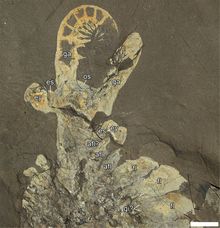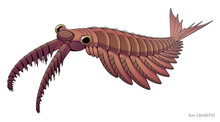Anomalocaris
| Anomalocaris | |
|---|---|

| |
| ROMIP 51212, a largely complete specimen of Anomalocaris canadensis. | |

| |
| Life restoration of Anomalocaris canadensis. | |
| Scientific classification | |
| Domain: | Eukaryota |
| Kingdom: | Animalia |
| Phylum: | Arthropoda |
| Class: | †Dinocaridida |
| Order: | †Radiodonta |
| Family: | †Anomalocarididae |
| Genus: | †Anomalocaris Whiteaves, 1892 |
| Species | |
(8 more unnamed species[3]) | |
Anomalocaris ("unlike other shrimp", or "abnormal shrimp") is an extinct genus of
It is best known from the type species A. canadensis, found in the Stephen Formation (particularly the Burgess Shale) of British Columbia, Canada. The species A. daleyae is known from the somewhat older Emu Bay Shale of Australia.[2] Other undescribed remains are known from China and the United States.[3]
Like other radiodonts, Anomalocaris had swimming flaps running along its body, large compound eyes, and a single pair of segmented, frontal appendages, which in Anomalocaris were used to grasp prey. Measuring up to 38 cm (1.25 ft) long excluding frontal appendages and tail fan,[4] A. canadensis is one of the largest animals of the Cambrian, and thought to be one of the earliest examples of an apex predator,[5][6] though others have been found in older Cambrian lagerstätten deposits.
Since the original description in late 19th century,
Discovery and identification
From the start, Anomalocaris fossil was misidentified, followed by a series of misidentifications and taxonomic revisions. Body or abdominal segments, which, in all the specimens collected, are abnormally flattened laterally, a little higher or deeper than long, broader above than below, the pair of ventral appendages proceeding from each, nearly equal in height or depth to the segment itself... The generic name Anomalocaris (from ανώμαλος, unlike,—καρίς, a shrimp, i.e., unlike other other shrimps) [the species name referring to Canada] is suggested by the unusual shape of the uropods or ventral appendages of the body segments and the relative position of the caudal spine.[7] In 1928, Danish paleontologist Kai Henriksen proposed that Tuzoia, a Burgess Shale arthropod which was known only from the carapace, represented the missing front half of Anomalocaris.[8] The artists Elie Cheverlange and Charles R. Knight followed this interpretation in their depictions of Anomalocaris.[8]
Not known to scientists at the time, the body parts of relatives of Anomalocaris had already been described but not recognized as such. The first fossilized mouth of such a kind of animal was discovered by Charles Doolittle Walcott, who mistook it for a jellyfish and placed it in the genus Peytoia. Walcott also discovered a frontal appendage but failed to realize the similarities to Whiteaves' discovery and instead identified it as feeding appendage or tail of the coexisted Sidneyia.[18] In the same publication in which he named Peytoia, Walcott named Laggania, a taxon that he interpreted as a holothurian.
In 1966, the Geological Survey of Canada began a comprehensive revision of the Burgess Shale fossil record, led by
In 2011[22] and 2020,[23] compound eyes of Anomalocaris were recovered from a paleontological dig at Emu Bay on Kangaroo Island, Australia, proving that Anomalocaris was indeed an arthropod as had been suspected. The find also indicated that advanced arthropod eyes had evolved very early, before the evolution of jointed legs or hardened exoskeletons.[22]
In 2021, "A." saron[24] and "A." magnabasis[25] were reassigned to the new genus Houcaris, in the family Tamisiocarididae.[26] In the same year, "A." pennsylvanica was reassigned to the genus Lenisicaris.[3] In 2022, specimen ELRC 20001 that was treated as an unnamed species of Anomalocaris or whole-body specimen of A. saron got a new genus, Innovatiocaris.[27] In 2023, "A". kunmingensis was reassigned to the new genus Guanshancaris in the family Amplectobeluidae.[28] Multiple phylogenetic analyses also suggested that "A". briggsi (tamisiocaridid) was not a species of Anomalocaris either,[29][30][31][4][32][33][34] and it was reassigned to the genus Echidnacaris in the family Tamisiocarididae in 2023.[2] In the same 2023 study, a new species of Anomalocaris, A. daleyae, was described based on remains found in the Emu Bay Shale in Australia.[2]
Description

For the time in which it lived, Anomalocaris was gigantic. A. canadensis is estimated to be up to 37.8 cm (1.24 ft) long excluding frontal appendages and tail fans.[4][27] Previous estimation up to 1 m (3.3 ft)[20] is unlikely based on the ratio of body parts (body length measured only about 2 times the length of frontal appendage in A. canadensis, respectively[4]) and the size of largest frontal appendage (up to 18 centimetres (7.1 inches) in length when extended).[18][4]
Anomalocaris propelled itself through the water by
-
The mobility of radiodont trunk appendages (like Anomalocaris).
-
The head sclerite structure of Anomalocaris.
Anomalocaris had an unusual disk-like mouth known as oral cone. The oral cone was composed of several plates organized triradially. Three of the plates were quite large. Three to four medium sized plates could be found between each of the large plates, and several small plates between them. Most of the plates wrinkled and have scale-like tubercles near the mouth opening.[10][39] Such an oral cone is very different from those of a typical hurdiid radiodont like Peytoia and Hurdia, which is smooth and tetraradial.[10][33] As a shared character across radiodonts, Anomalocaris also had three sclerites on the top and side of its head.[33] The top one, known as a head shield, dorsal carapace or H-element, was shaped like an laterally-elongated[40] oval, with a distinct rim on the outer edge.[38] The remaining two lateral sclerites, known as P-elements, were also ovoid, but connected by a bar-like outgrowth.[33] The P-elements were previously misinterpreted as two huge compound eyes.[38][33]

Two large frontal appendage were positioned in front of the mouth, at the front of the head.[8] Each frontal appendage of Anomalocaris usually had 14 podomeres (segmental units, at least 1 for shaft and 13 for distal articulated region), with each appendage being laterally-flattened (taller than wide).[38] Most podomeres were tipped with a pair of endites (ventral spines).[38] The endites themselves were both equipped with multiple auxiliary spines, which branches off from the anterior and posterior margin of the endites.[24][39][41][38][1]
The tail was a large tail fan, composed of three
Based on fossilized eyes from the
Paleobiology
Diet

The interpretation of Anomalocaris as an active
However, the long-standing idea that Anomalocaris fed on hard-bodied animals, especially its ability to penetrate mineralized

The lack of wear on radiodont mouthparts suggests they did not come into regular contact with mineralized trilobite shells, and were possibly better suited to feeding on smaller, soft-bodied organisms by suction, since they would have experienced structural failure if they were used against the armour of trilobites.
Bicknell et al. (2023) examined the frontal appendages of Anomalocaris, suggesting it was an active nektonic apex predator. Postured with the frontal appendages outstretched, Anomalocaris would have been able to swim with maximized speed, similar to modern predatory water bugs. Its eyes would be suitable to hunt prey in well-lit waters. Anomalocaris would have hunted various free-swimming animals since there are a large diversity of nektonic and pelagic soft-bodied animals. It probably would have not hunted benthic animals like trilobites, considering the possibility of damaging the frontal appendages on the substrate while trying to grab prey from seafloor at speed. Instead, other animals such as other radiodonts (e.g. Hurdia, Cambroraster, Titanokorys, Stanleycaris) and artiopods (e.g. Sidneyia) would have been benthic predators in the Burgess Shale.[5][6]
Paleoecology
Specimens of Anomalocaris have been found worldwide spanning from
Anomalocaris canadensis lived in the Burgess Shale in relatively great numbers.[1] In the Burgess Shale, Anomalocaris is more common in the older sections, notably the Mount Stephen trilobite beds. However, in the younger sections, such as the Phyllopod bed, Anomalocaris could reach much greater sizes; roughly twice the size of its older, trilobite bed relatives. These rare giant specimens have previously been referred to a separate species, Anomalocaris gigantea; however, the validity of this species has been called into question,[20] and is currently synonymized to A. canadensis.[38]
Other unnamed species of Anomalocaris live in vastly different environments.[3] For example, Anomalocaris cf. canadensis (JS-1880) lived in the Maotianshan Shales,[3] a shallow tropical sea or even being delta[48] in what is now modern China. Anomalocaris daleyae (Emu Bay Shale) lived in a comparable environment; the shallow, tropical waters of Cambrian Australia.[3] The Maotianshan Shale and the Emu Bay Shale are very close in proximity, being separated by a small landmass, far from the Burgess Shale.[3] These two locations also included "Anomalocaris" kunmingensis and "Anomalocaris" briggsi respectively, species that previously attributed[49][50][39][51] but taxonomically unlikely to be a member of Anomalocaris nor even Anomalocarididae.[3][52]
See also
- 8564 Anomalocaris, an asteroid named after this animal.
- Radiodonta, extinct arthropod order composed of Anomalocaris and its relatives.
- Houcaris, Lenisicaris, Innovatiocaris, Guanshancaris, Echidnacaris, radiodont genera containing species originally named as Anomalocaris.
- Aegirocassis, a giant filter-feeding radiodont from Ordovician Morocco.
- Cambrian explosion, the large bio-diversification event that occurred during the Cambrian.
- Opabinia, a genus of bizarre stem-group arthropod distantly related to the radiodonts.
- carbonaceousscales, and lived alongside Anomalocaris.
- Paleobiota of the Burgess Shale
Footnotes
- ^ .
- ^ S2CID 259719252.
- ^ S2CID 233565727.
- ^ PMID 30218075.
- ^ PMID 34284622.
- ^ PMID 37403497.
- ^ a b c Whiteaves JF (1892). "Description of a new genus and species of phyllocarid Crustacea from the Middle Cambrian of Mount Stephen, B.C." Canadian Record of Science. 5 (4): 205–208.
- ^ S2CID 131622496.
- ^ .
- ^ S2CID 2042726.
- OCLC 18983518.
- ^ "The Burgess Shale: First Discoveries". burgess-shale.rom.on.ca. Royal Ontario Museum. Retrieved 2023-03-25.
- ISBN 978-0-521-45405-6, retrieved 2023-03-25
- ISBN 9781014253446.
- S2CID 131669387.
- ^ Briggs DE (1979). "Anomalocaris, the largest known Cambrian arthropod". Palaeontology. 22 (3): 631–664.
- ^ Whiteaves JF (1892). "Description of a new genus and species of phyllocarid Crustacea from the Middle Cambrian of Mount Stephen, B. C.". The Canadian Record of Science. 5 (4).
- ^ ISBN 978-0-393-02705-1.
- JSTOR 1303799.
- ^ a b c Briggs DE (1979). "Anomalocaris, the largest known Cambrian arthropod". Palaeontology. 22 (3): 631–664.
- ^ ISBN 978-0-19-850256-2.
- ^ S2CID 2568029.
- ^ PMID 33268353.
- ^ ISSN 1103-5897.
- ^ S2CID 204260554.
- ^ S2CID 235221043.
- ^ S2CID 252147346.
- PMID 37106783.
- S2CID 205237459.
- S2CID 4451239.
- S2CID 205242881.
- ISSN 2095-5138.
- ^ PMID 31362637.
- S2CID 236552819.
- ^ PMID 16002096.
- ^ .
- PMID 17780843.
- ^ S2CID 86683798.
- ^ .
- S2CID 133549817.
- S2CID 129212098.
- PMID 29697774.
- PMID 30518575.
- PMID 24785191.
- ^ De Vivo G, Lautenschlager S, Vinther J (16 December 2016). Reconstructing anomalocaridid feeding appendage dexterity sheds light on radiodontan ecology (Report).
- ^ ISBN 978-0-9812885-1-2.
- ^ .
- PMID 35322027.
- ^ Nedin, Christopher (1995). The Emu Bay Shale, a Lower Cambrian fossil Lagerstatte, Kangaroo Island, South Australia.
- ISSN 1861-9541.
- ^ Jeanes J. "Mapping the world's Burgess Shale-type deposits". www.virtualmuseum.ca. Retrieved 2019-09-16.
- ISSN 0567-7920.
External links
- "Anomalocaris canadensis". Burgess Shale Fossil Gallery. Virtual Museum of Canada. 2011. Archived from the original on 2020-11-12. Retrieved 2023-01-21.
- Anomalocaris 'homepage' with swimming animation
- Burgess Shale: Anomalocaris canadensis (proto-arthropod), Smithsonian.



